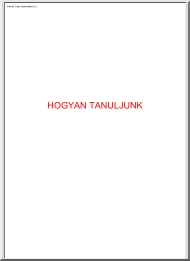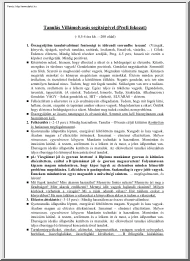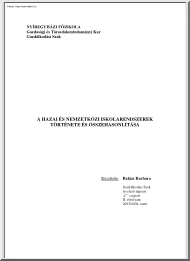Datasheet
Year, pagecount:2015, 3 page(s)
Language:English
Downloads:4
Uploaded:November 13, 2017
Size:776 KB
Institution:
-
Comments:
Attachment:-
Download in PDF:Please log in!
Comments
No comments yet. You can be the first!Content extract
Source: http://www.doksinet Essay teacher guide This resource is designed to help you to plan your teaching to prepare students for the essay in A-level Paper 3. It has been designed for a number of teachers in the same department to work together, but could be adapted for single teachers, or for use with students. Throughout the development of our new A-level Biology specification, we spoke to teachers and university experts. We were told that extended writing was an important skill that students should be developing. The 25 mark essay has been an element of our A-levels for many years, going back several specifications. It is at its heart a synoptic essay Students who write in detail on one single area will not gain high marks. They must instead demonstrate their ability to draw together concepts from throughout the course and relate them to the title given. At first, you can worry that this is difficult for your students and will mean a large amount of marking. In many ways, essays
are a much more positive way of assessing than other forms of question that cover large areas of the specification. As there are two titles, students can pick the one that bests fits their knowledge of Biology and show what they know. The Biology essay produces a very satisfactory range of marks from all candidates, showing that it allows candidates of all abilities to demonstrate their knowledge. The graph below shows the spread of marks for all candidates in the Biology essay in 2014. As would be expected, it is difficult, but not impossible, to gain full or almost full marks in the essay. What is perhaps even more reassuring is that very few students gain little or no marks. This shows how even the weakest candidates can gain marks by writing something on the essay and shows that it is worth putting time into preparation of all students. Source: http://www.doksinet Teacher guide elements Teacher guide to A-level essay contains four elements: A training schedule
– showing how a CPD session could be run with teachers A presentation – covering the major points of the essay A set of past paper essay titles and the indicative content from the mark schemes A set of essays that have previously been marked. Changes to mark scheme The mark scheme for the Biology essay is changing. Previously, it included several elements. Each essay was separately marked on four areas: quality of written communication (QWC), breadth, content and relevance. The new specification uses a ‘level of response’ mark scheme which combines all four of these areas into one set of marking guidelines. Comments on the previously marked questions relate to the previous mark scheme. With a slightly different mark scheme, it is likely that there would be slight changes to the marks given to any given essay, so the marks shown should be seen as indicative only. Training schedule 1. Work through slide two of the presentation 2. Hand out copies of the titles from essays for
the last few years Do not give out the indicative content yet. Are the titles what you would expect? Are there titles that you would immediately identify as easier to answer than others? 3. Read through slide three 4. Choose a couple of essay titles from the last few years Work together to list the topics from the specification that could be included in an essay relating to this title. 5. Hand out the indicative content for each essay title Compare the list of titles that you produce with the indicative content list for those topics. You will see that: a. titles are broad, so can cover many aspects, b the topics in the indicative content are what they would expect. 6. Read through the mark scheme on slides four – six of the presentation Things to note: Source: http://www.doksinet Quality of written communication is integrated – it’s not about spelling, it’s about correct use of terminology An essay that focuses only on one or two topics is only worth
a maximum of 10 marks Essays that deal with a number of topics need to have links between the topics to gain high marks For the very top marks (only), reading outside the A-level is encouraged. 7. Choose an essay title Divide five or six topics from the indicative content list up between you. Everyone writes a paragraph on each of their topics, relating it to the essay title. You should spend no more than five minutes on each paragraph. What you will have produced is a series of separate paragraphs, each on a topic related to the title. Putting these together would form a rudimentary essay. Although the Biology is (likely to be) correct, the individual paragraphs do not form an ‘interrelated’ whole, which would limit the marks available. 8. You should then spend some time considering how you would link each paragraph/topic to each other, and in which order. 9. Hand out the marked candidate answers It is worth noting at this point that most candidates write an essay plan of some
sort at the start of their essay. It’s also worth noticing that students’ handwriting can make a big difference to examiners’ ability to mark effectively. 10. In pairs, you should mark some of the answers using the new mark scheme You should then compare the mark you give the essay with the mark on the answer (typed section at the end). As has been mentioned, this mark was given using the old mark scheme, but should give an indication of roughly the mark that the answer would be expected to get using the new scheme. 11. Read through the last three slides of the presentation Discuss how you will prepare your students for the essay question
are a much more positive way of assessing than other forms of question that cover large areas of the specification. As there are two titles, students can pick the one that bests fits their knowledge of Biology and show what they know. The Biology essay produces a very satisfactory range of marks from all candidates, showing that it allows candidates of all abilities to demonstrate their knowledge. The graph below shows the spread of marks for all candidates in the Biology essay in 2014. As would be expected, it is difficult, but not impossible, to gain full or almost full marks in the essay. What is perhaps even more reassuring is that very few students gain little or no marks. This shows how even the weakest candidates can gain marks by writing something on the essay and shows that it is worth putting time into preparation of all students. Source: http://www.doksinet Teacher guide elements Teacher guide to A-level essay contains four elements: A training schedule
– showing how a CPD session could be run with teachers A presentation – covering the major points of the essay A set of past paper essay titles and the indicative content from the mark schemes A set of essays that have previously been marked. Changes to mark scheme The mark scheme for the Biology essay is changing. Previously, it included several elements. Each essay was separately marked on four areas: quality of written communication (QWC), breadth, content and relevance. The new specification uses a ‘level of response’ mark scheme which combines all four of these areas into one set of marking guidelines. Comments on the previously marked questions relate to the previous mark scheme. With a slightly different mark scheme, it is likely that there would be slight changes to the marks given to any given essay, so the marks shown should be seen as indicative only. Training schedule 1. Work through slide two of the presentation 2. Hand out copies of the titles from essays for
the last few years Do not give out the indicative content yet. Are the titles what you would expect? Are there titles that you would immediately identify as easier to answer than others? 3. Read through slide three 4. Choose a couple of essay titles from the last few years Work together to list the topics from the specification that could be included in an essay relating to this title. 5. Hand out the indicative content for each essay title Compare the list of titles that you produce with the indicative content list for those topics. You will see that: a. titles are broad, so can cover many aspects, b the topics in the indicative content are what they would expect. 6. Read through the mark scheme on slides four – six of the presentation Things to note: Source: http://www.doksinet Quality of written communication is integrated – it’s not about spelling, it’s about correct use of terminology An essay that focuses only on one or two topics is only worth
a maximum of 10 marks Essays that deal with a number of topics need to have links between the topics to gain high marks For the very top marks (only), reading outside the A-level is encouraged. 7. Choose an essay title Divide five or six topics from the indicative content list up between you. Everyone writes a paragraph on each of their topics, relating it to the essay title. You should spend no more than five minutes on each paragraph. What you will have produced is a series of separate paragraphs, each on a topic related to the title. Putting these together would form a rudimentary essay. Although the Biology is (likely to be) correct, the individual paragraphs do not form an ‘interrelated’ whole, which would limit the marks available. 8. You should then spend some time considering how you would link each paragraph/topic to each other, and in which order. 9. Hand out the marked candidate answers It is worth noting at this point that most candidates write an essay plan of some
sort at the start of their essay. It’s also worth noticing that students’ handwriting can make a big difference to examiners’ ability to mark effectively. 10. In pairs, you should mark some of the answers using the new mark scheme You should then compare the mark you give the essay with the mark on the answer (typed section at the end). As has been mentioned, this mark was given using the old mark scheme, but should give an indication of roughly the mark that the answer would be expected to get using the new scheme. 11. Read through the last three slides of the presentation Discuss how you will prepare your students for the essay question





